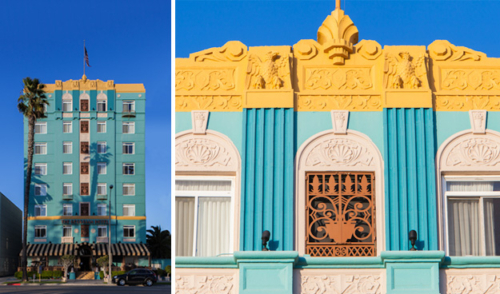Georgian Hotel

- Known As
- Art Deco
- Architect
- M. Eugene Durfee
- Built
- 1931
- Designated
- February 22, 1995
Santa Monica has long been a desirable destination for tourists and fun-seekers. In the city’s earliest days, vacationers pitched tents on the beach and swam in the surf. As the city grew, so did the sophistication of its amenities for tourists. By the 1920s Santa Monica offered chic and expensive hotels, luxurious beach clubs, and plenty of opportunities for fun.
Although the Depression, starting in 1929, curtailed Santa Monica’s leisure industry, there were still enough well-heeled customers coming to Santa Monica to justify the construction of the Georgian Hotel in 1931. Thanks to its prime location and up-to-the-minute architecture, the Georgian quickly attracted a stylish clientele, reputed to include numerous Hollywood celebrities. Part of the draw was the hotel’s speakeasy where customers could drink in comfort and privacy in the years before Prohibition was repealed.
The Georgian Hotel was the work of locally prominent architect M. Eugene Durfee. Perhaps Durfee’s most visible work, aside from the Georgian, is the pared-down Art Deco Central Tower Building at 1424 Fourth Street, completed in 1929. At the Georgian Hotel, Durfee opted for a more ornate style—incorporating Period Revival stylistic elements into an Art Deco design. (Footnote #1)
Period Revival features include the building’s overall symmetry and the fact that its entrance is above street level, reached by a flight of stairs. Small balustraded balconies (located just above the awning) also give a nod to the style. Differing treatment of different stories is also typical. Here, for example, the lower parts of the façade are incised to resemble large blocks of stone while upper stories feature flat stucco.
Despite the use of these historic elements, the Georgian Hotel comes across, first and foremost, as an Art Deco creation. Art Deco, as the name implies, tended toward artistic decoration, and such ornamentation is plentiful here. The Georgian Hotel features numerous low-relief plasterwork panels embellished with favorite Art Deco motifs, including stylized foliage and scallop shells. These plasterwork elements are interspersed with decorative metal panels which mix graceful scrolls with more angular shapes. Numerous other decorative details, as well as a lavishly embellished area near the roofline, convey a sense of opulence and plenty confirming that Art Deco was an optimistic style, despite the era in which it flourished.
This eight-story hotel was, for many years, one of the tallest structures in Santa Monica. Its striking look advertised Santa Monica as a modern and beautiful place to be. Today the Georgian Hotel stands out both as a monument to the city’s long tradition as a tourist and leisure destination and to the golden age of Art Deco.
Footnote:
Some publications have characterized the building as Art Deco with Period Revival elements. However, only the rounded arches on the first floor of the front façade might qualify as Period Revival and the building lacks other hallmarks of the style.
Sources:
- David Gebhard and Harriette Von Breton. L.A. in the Thirties: 1931-1941. Peregrine Smith, 1975.
- Cyril M. Harris. American Architecture: An Illustrated Encyclopedia. New York: W.W. Norton, 1998.
- Sam Hall Kaplan. LA Lost and Found: An Architectural History of Los Angeles. New York: Crown Publishers, 1987.
- Santa Monica Historical Resources Inventory, 1985-1986. Vol. 3. City of Santa Monica, Building and Safety Department.
- Santa Monica Landmarks Tour. Santa Monica: City Planning Division, 2004.